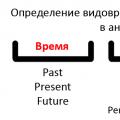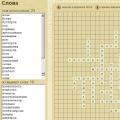Educational games for children to memorize English numbers. Numbers in English English numbers from 1 to 10 print
When we teach English to children, we certainly have to study numbers. To know how to read and write numbers in English, you have to spend a lot of time with your children. Coloring books and fascinating videos with correct pronunciation and translation in Russian will come to the aid of parents and educators.
How to learn English numbers effectively and quickly?Coloring pages
Here is a coloring book - numbers on English. Print and color it with your child, and then hang it, for example, on the wall and from time to time come up and list the numbers in English or ask the child to show where this or that number is.
Numbers in English can be used both for classes at home and for classes in early development groups or kindergarten. Kids love to color everything, give them this opportunity, and at the same time learn numbers in English. This section contains numbers in English up to 10.
Materials
 Numbers from 1 to 20 with English and Russian pronunciation.
Numbers from 1 to 20 with English and Russian pronunciation. Copybooks
Video tutorials
To develop the correct pronunciation of numbers, sometimes cards with transcription are not enough. To read numbers correctly, use cartoons and other video aids in your classes that involve dialogue or a song. Thanks to the speaker, you will practice pronunciation as close as possible to the original.
The big numbers song
This cartoon will be useful to reinforce the pronunciation of numbers up to 10 in English, as well as to learn tens. Throughout the video, the numbers are sung in a pleasant melodic voice of the announcer. Repeating after him is a pleasure, since all the words are pronounced clearly and understandably, and the meaning of the number is presented in the form of a picture or number. Can be recommended for children aged 4-5 years. You can watch the cartoon here:
Numbers Song
This cartoon in English is much more interesting. Children will be able not only to practice the pronunciation of numbers they already know, but also to enjoy a colorful video. There are not only numbers here: simple stories are told, songs are sung, etc. The child will not necessarily understand everything right away: it is better to watch the cartoon several times to understand its content. In addition, numbers are not simply listed here, but literally shown how, for example, 4 turns into 5, etc., i.e. children are led to perform mathematical operations. The cartoon can be recommended for children from 3 years old. You can watch it here:
Let's Count to 20 Songs For Kids
This video can rather be called author's, and the performer is present on the screen. In this regard, the cartoon can be recommended for children aged 4-5 years. Here we teach the pronunciation of counting from 1 to 20 in the form of a song to a smooth melody. Unfortunately, the cartoon is quite monotonous and is more suitable for group listening in classes than for home viewing. You can download or watch it here:
Learn Numbers Song 1 to 100 Counting
This training manual for children school age. Here the count goes up to a hundred, but there are very few spectacular elements. Numbers alternate on the screen, made in the form of 3D animation. The counting goes like a song to a melody, so it will be easy to remember. You can download the video here:
So, videos and coloring pages with transcription will help you teach your child to read and pronounce numbers correctly, as well as write them in cursive. Do not neglect such valuable benefits and a great opportunity to be useful to your children.
Knowing how to count in English is as important as speaking it. In any tourist country, all salespeople, taxi drivers, and hotel staff have a count of up to 20. Are you any worse? In general, you understand what's what. To learn how to count to a million in English, you need to learn only 31 words. But everything is in order. In this article we will learn how to count to 20.
In Russian, to learn numbers, you need to know over 100 words. In English invoice the same rules apply, but it is worth mentioning a couple important points, which will greatly facilitate the process of learning numbers and numbers:
- In English, unlike Russian, numbers are not declined according to gender. If we have “two thousand”, but “two million”, then here it is the same as “two thousand”, as “two million”
- They do not decline according to cases, that is, the endings do not change. Instead of “a thousand - thousand-thousand-thousand...”, for everything the simple word “thousand”
- Also, instead of "1 million - 2 million - 5 million" it all comes down to using one word "million" and no additional endings
- There are no personal names for hundreds. Instead of “two hundred” there will be “two hundred”, instead of “six hundred” the Englishman will say “six hundred”, etc.
- Well, fifthly, there are much fewer exceptions in the English account
Well, now let’s move from theory directly to practice: Numbers from one to ten are the basis of the basics!
Numerous numbers are based on basic numbers- from 1 to 9, you can also include 0 and 10 here. You will just have to memorize these numbers:
Number | English | Translation | English transcription | |
| One | One | [one] | ||
| Two | Two | [that] | ||
| Three | Three | [θri:] | [sry] | |
| Four | Four | [fo] | ||
| Five | Five | [five] | ||
| Six | Six | [syks] | ||
| Seven | Seven | [sevn] | ||
| Eight | Eight | [eight] | ||
| Nine | Nine | [nine] | ||
| Ten | Ten | [ten] |
Further, the next numbers 11 and 12 are those few exceptions from the top 20. You will have to remember them too. Then everything is much simpler. From the 13th to the 19th the numbers are formed in the same way “digit (3 to 9) + teen”. For example, six + teen = sixteen. Similar to thirteen, fifteen in Russian. This is -eleven and is -teen. The number is written together and read with the emphasis on the last syllable.
Number | English | Translation | English transcription | Transcription in Russian letters |
| Ten | Ten | [ten] | ||
| Eleven | Eleven | [ilevn] | ||
| Twelve | Twelve | [tuelv] | ||
| Thirteen | Thirteen | [‘θə:tin] | [shotin] | |
| Fourteen | Fourteen | [‘fo:tin] | [photin] | |
| Fifteen | Fifteen | [‘fi:ftin] | [fiftin] | |
| Sixteen | Sixteen | [‘sikstin] | [sykstin] | |
| Seventeen | Seventeen | [‘sevntin] | [sevntin] | |
| Eighteen | Eighteen | [‘eitin] | [atein] | |
| Nineteen | Nineteen | [‘naintin] | [nightteen] | |
| Twenty | Twenty | ['twenti] | [twenty] |
There are minor changes here too. In pronunciation they are not noticeable, but in writing it is worth paying attention to the radical changes:
- 13: The spelling of "three" is modified to "thir"
- 15: in the second syllable "five" the v changes to f and the letter "e" disappears
- 18: when adding the suffix “teen” to “eight”, the letter t that appears is not duplicated, but replaced with a single letter
In fact, the ending “teen” is a full-fledged word meaning the age from 13 to 19 years.
It should be taken into account that Russian pronunciation(transcription) - this is only an approximate sound; the specific sound of English numbers cannot be 100% conveyed.How to teach a child to count in English?
Once you start teaching your children English, it also needs to be taught numeracy. Be sure to do this through play to instill in him a love and desire to learn the language. Here are some ways to teach your child to count in English:

- Buy or download number cards from the Internet. It is better if on each of them it is written in letters and with pronunciation. Lay out the pictures on the floor. Say the number in English, and let the child bring you the card you need or point to it
- The previous game, only the adult already names the number in his native language, and the child takes a card with a number and calls it in a foreign language
- Take the ball. Stand opposite, and throwing the ball into the child’s hands, say the number in a foreign language, and the child, returning the toy to you, says it in his native language.
- Game "Who has more". Turn the cards over with the numbers down, and draw out one picture at a time with your baby. Say the number in English. Whoever has more gets both cards. And so on until the end. The one with the highest amount wins
- Ask your child to draw numbers, give them human features - eyes, hands, and their name will be the name of the number
- Use engaging rhymes that children can easily remember.
- Another option is the game “Crocodile”, but instead of words, the child must turn into a number
- You can also ask your child to draw a number that you will voice in the air.
The first question that worries parents is: “Isn’t it difficult for children to remember and reproduce numbers in English?” We answer: “On the contrary! Not only is it not difficult, but it’s also pleasant.” You just need to get to know them in a playful, unobtrusive way, especially if the baby is a preschooler.
English numbers and numbers: what do we study and how?
The first thing to start with is the usual numbers from 0 to 9. Below we provide the data necessary for parents: numbers, their “names” and transcription.
| 0 | Zero (oh) | ["ziərəu] ([əu]) | Zero |
| 1 | One | One | |
| 2 | Two | Two | |
| 3 | Three | [θriː] | Three |
| 4 | Four | Four | |
| 5 | Five | Five | |
| 6 | Six | Six | |
| 7 | Seven | [‘sev(ə)n] | Seven |
| 8 | Eight | Eight | |
| 9 | Nine | Nine | |
| 10 | Ten | Ten |
There are two opinions regarding transcription:
- Children should be taught foreign phonetics right away, that is, use classical transcription.
- You can use a Russified version of pronunciation, for example, 4 - fo, 1 - van or uan.
In our opinion, it is better to resort to the first method in order to immediately place and fix the sounds in their correct form. Unfamiliar cases, for example, interdental [θ] can be played out using the articulation exercise “tongue in a window” (the tip of the tongue looks out of the window formed by the teeth, as if looking out into the street, while the child is asked to blow on the tip of the tongue and let the air out). The result will be the desired sound.
And, having become familiar with the names of numbers, the child will be able to add more complex “names” of numbers from them.
A little about the teaching methodology
First of all, for a preschool child, the game and everything connected with it are of particular interest. Therefore, when learning numbers in English, it is important to use original videos, bright pictures, songs, poems, counting rhymes and other children's interesting things.
Let the learning process not be boring school lessons. Communicate with the child, speak emotionally (of course, in a positive way), use different types of activities, alternate them often enough so that the baby does not have time to get tired. Pay attention to his interest, stimulate it. And under no circumstances force him, especially for preschoolers.
Games, exercises and other “useful things” for children
For a unique workout with the kids, you can use the following ideas.

In a word, there are no limits to imagination. Add some variety to your dull everyday life, go back to your childhood and play with your child. It will be both fun and useful for both! Good luck to you and your children! And finally, a small task:

Say the house number of each animal in English
30 counting songs in English with karaoke option:
Baby! Don't be afraid to learn something new! If you know numbers in Russian, then you will definitely know how they are written and pronounced in English. In that distant country of England, numbers are written and pronounced a little differently, they are not at all complicated. Now let's look a little at the history of numbers.
A short course on the history of numbers
There used to be primitive people, they were exploring this world, just like you are now. And they noticed that they had five fingers on each hand. Look at your hand now. Do you see? You have five fingers. And the second hand has five fingers. And if you add them up, it turns out that you have ten fingers on both hands. People realized that numbers could be written down somehow, for example on stones, because there were no pens and pencils then.
You may ask, why should I write it down? Well, you can, for example, write down a number on paper and remember that they bought you two ice creams yesterday and now you already need three ice creams. Now we will stop at the history course and move straight to the numbers.
Table of numbers from 1 to 20
| Number | Number name in English | Transcription of English numerals | Approximate pronunciation of an English number in Russian | Name of English numeral in Russian |
| 0 | zero | [´ziərəu] | ´zierou | zero |
| 1 | one | one | one | |
| 2 | two | that:* | two | |
| 3 | three | [θri:] | sri:** | three |
| 4 | four | fo: | four | |
| 5 | five | five | five | |
| 6 | six | syx | six | |
| 7 | seven | sevn | seven | |
| 8 | eight | eith | eight | |
| 9 | nine | nain | nine | |
| 10 | ten | ten | ten | |
| 11 | eleven | i´levn | eleven | |
| 12 | twelve | tuelv | twelve | |
| 13 | thirteen | [θə:´ti:n] | sho´ti:n** | thirteen |
| 14 | fourteen | fo´ti:n | fourteen | |
| 15 | fifteen | fifty:n | fifteen | |
| 16 | sixteen | syx´ti:n | sixteen | |
| 17 | seventeen | sevn´ti:n | sevn´ti:n | seventeen |
| 18 | eighteen | hey:n | eighteen | |
| 19 | nineteen | nain´ti:n | nineteen | |
| 20 | twenty | [´twenti] | tu´enti | twenty |
Want to learn more numbers? For example.
One of the ways to remember effectively English vocabulary- this is the use of cards (see in the “Cards” section)
If you haven't tried studying this way yet english words, feel free to proceed, as this is one of the most effective ways teaching English.
In this material, we suggest using cards to learn English words on the topic “Numbers”:
- Coloring pages: in English
- / Learn English numbers from 1 to 10 with translation and transcription
- Numerals / Russian-English poems (agreements) on the topic ""
This simple and uncomplicated poem will help children quickly learn the numbers from 1 to 10 in English, as well as expand their vocabulary on general topics.
Text of a poem about numbers in English with translation into Russian
Technique for creating cards “Numbers in English”
1. Print the cards on a color printer (two pictures on one A4 page);
2. Cut the page into two parts (or simply fold it in half);
3. Glue so that there is a number on one side and a picture on the other side.
4. Pictures can be laminated (for example, with tape).
 Integrals of trigonometric functions
Integrals of trigonometric functions How to determine the tense of a verb?
How to determine the tense of a verb? Crosswords in English on various topics Crossword in physics in English
Crosswords in English on various topics Crossword in physics in English